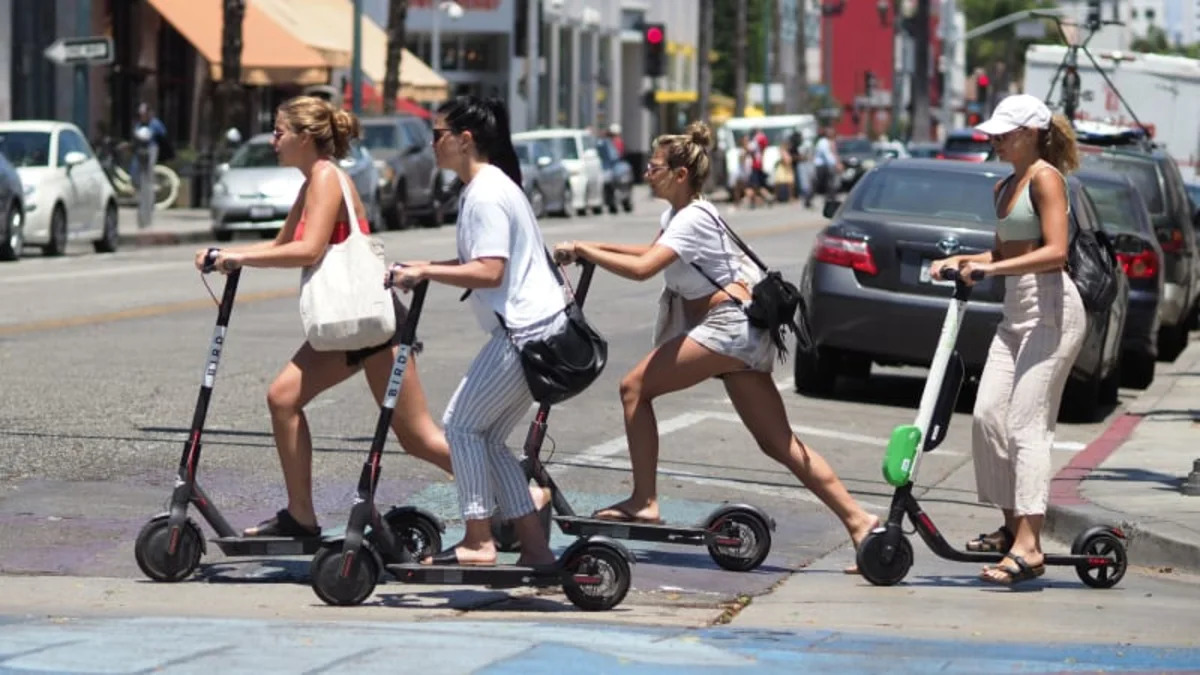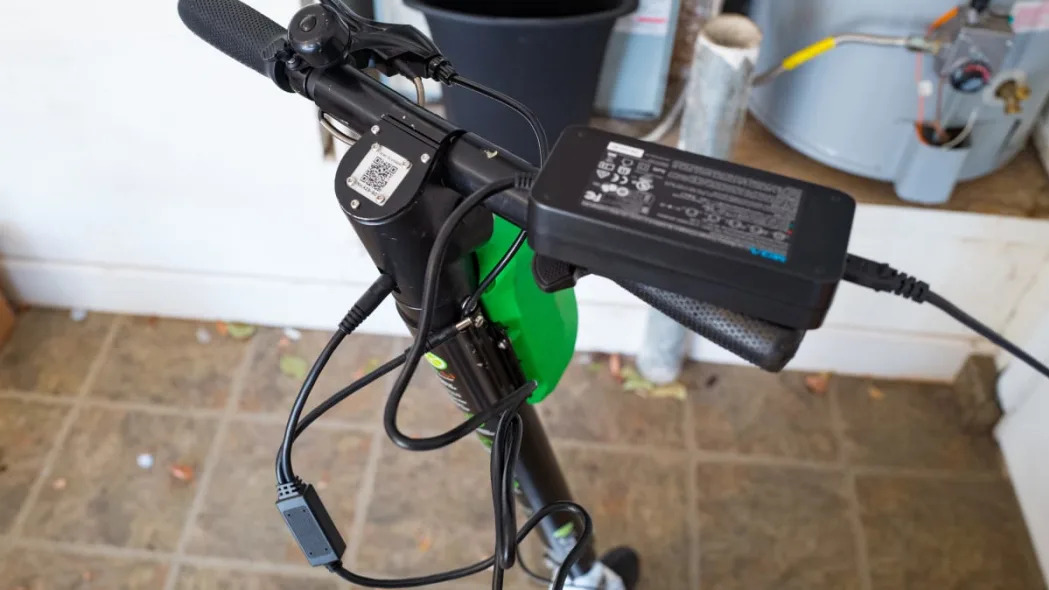Electric scooters have become quite the rage over the last couple of years, but unlike some of the other new forms of disruptive transportation produced by the gig economy, e-scooters have disrupted life in cities in some particularly unpleasant ways.
That’s in large part due to the way e-scooter companies, such as Bird, Lime, Skip and Spin have structured their services. Instead of having fixed docks sprinkled around the city where people can pick the scooters up and drop them off, they work on a “dockless” system. This means people can literally drop them off wherever they like. And they do. People dump them haphazardly on sidewalks, leaving them for people to trip over or walk around. They are often times ridden illegally on sidewalks as well, leaving pedestrians to dodge them.
As a result of the chaos they’ve caused they’ve been suspended or outright outlawed in various jurisdictions around the country. Early on, San Francisco instituted the Powered Scooter Share Permit Program that limited the number of companies that could operate the scooters as well as the number of scooters each company could operate. But before allowing the companies back on the streets, they first mandated that all scooters be removed for a time.
Electric scooters are pay-by-the-minute transportation that is especially helpful to people in their first and/or last mile of travel. They are equipped with wireless connectivity and GPS so the company always knows where they are. The top speed for most e-scooters is around 15 miles per hour and they have a range of 10-15 miles.
Customers reserve them through an app on their phones. And every night teams of “chargers” go around and pick them up, take them usually to their homes where they charge them, and then put them back on the street, fully charged, early the next morning.
Now that many cities have come to terms with how to regulate scooters, it’s worth remembering that they were kicked out in the first place because people used them in ways that were inconsiderate of others and that greatly inconvenienced the non-scooter population. If you’re a fan of scooters and you’d like to see them stay around for a while, we should look at some scooter etiquette tips, that if observed by all users, would make it much less likely that they’ll ever be banned again.
E-scooter etiquette
Probably the most important point of e-scooter etiquette involves knowing where you should leave your scooter when you’ve finished using it. So many past users left their scooters in such inconvenient places that it became a major reason why so many cities eventually banned them.
Here are some best practices when it comes to parking scooters after your trip:
- In urban areas, scooters should be left on the sidewalk parked as close to the street as possible. Always make sure you’re leaving at least three feet of clearance between the scooter and the part of the sidewalk where most pedestrians walk;
- Parking scooters near public bike racks is another considerate place to leave them;
- Anywhere that either the scooter company or local regulations designate. The scooter companies are experimenting more with electronic geofencing and may give you more specific areas where you are to leave them. If so, follow their instructions.
Areas where you shouldn’t leave scooters are those which would cause disruptions to the normal flow of pedestrian traffic.
- Don’t leave them on sidewalk handicap ramps;
- Don’t leave them where they might block railings used by pedestrians;
- Don’t leave them where they might block access to bus stops or passenger waiting areas
- Don’t leave them where they would block access to outdoor benches, seats or tables;
- Don’t leave them in automobile parking spots.
The best rule of thumb is to look around and make sure you’re not leaving your scooter in any space that might impede or disrupt the flow of pedestrian or vehicular traffic.
E-scooter rules & safety
E-scooter safety starts with knowing the law. Many cities have recently passed laws governing the use of e-scooters. These laws, of course, differ from city to city. The scooter companies themselves also have their own rules that you have to abide by.
Most cities have laws that restrict e-scooter riders from riding on sidewalks. In these cities you must ride in the street with traffic and you must go in the direction of traffic. So, when you begin, become familiar with the laws of the city where you’ll be using an e-scooter. For instance, in cities with bike lanes, e-scooter users are generally required to use only the bike lanes.
Also become familiar with the rules of the companies from which you rent e-scooters. Most e-scooter companies require users to wear helmets — although none of them even make an attempt to enforce it. For example, from within Lime’s tutorial, the company suggests users wear a helmet, but there is no way to enforce that suggestion.
Some provide helmets at no charge, others sell them. But whether they require them or provide them or not, we highly recommend that you always wear a helmet. And it’s advisable to buy your own high-quality helmet rather than relying on the cheap-o versions that some of the scooter companies give away.
Accidents & injuries
There have been thousands of e-scooter injuries since this whole phenomenon began. The CDC estimates there are 20 accidents causing injury for every 100,000 trips.
A study conducted by public health officials in Austin, Texas, working in conjunction with the Centers for Disease Control in Atlanta between September 5th through November 30th, 2018, identified 271 people who had been involved in scooter-related accidents that caused injuries. Of those, almost half sustained head injuries. And 15% sustained traumatic brain injuries. Many of those injuries could have been prevented if the riders had worn helmets. But according to the study only one out of 190 injured scooter riders wore a helmet.
Electric scooters are not only dangerous in terms of how many injuries occur for every 100,000 trips, but they are also dangerous in terms of the severity of the injuries. In the CDC study almost half of the riders who were involved in accidents reported sustaining a “severe injury.” These injuries range from bone fractures (84%); nerve, tendon, or ligament injuries (45%); severe bleeding (5%); to serious organ damage (1%). And as of June, 2019, eight deaths have been tied to e-scooters.
More than half of the accidents that seriously injured riders occurred in the street and cars and other vehicles were involved in 16% of the injuries. 17% of injured riders hit an inanimate object such as a light pole or the curb.
“Charger” safety
We’ve talked about safety for riders but there is another side to the safety equation. The safety of the people who charge the scooter batteries. Each night, thousands independent contractors around the country head out to pick up scooters, that have been left all over their cities, to charge them.
Anyone who has a mobile phone and has signed up with one of the scooter companies to work as a “charger” can do this. After hours, the companies show the people who do the charging where the scooters are on a map. The first “charger” who physically gets to the scooter can claim it and will get paid around $4 - $8 to charge it and return it before the next morning.
The way the companies have designed this system has inherent dangers in it. By turning it into a competitive process the people doing the charging, some of the “charger” people have found themselves in dangerous situations.
Imagine two guys who are barely making minimum wage arrive upon a scooter at the exact same moment. Who gets it? What if they both are adamant about claiming it since they both put a lot of effort into getting there before anyone else? How do they decide who gets it? Do they make a deal? Does one of them say, “You take it this time and I’ll get it next time”? That won’t work because there’s a 99.99% chance they’ll never see each other again.
They’ve both put considerable time and effort into getting to the scooter and neither one can really afford to lose out on the few dollars he’ll make if he collects it and charges it.
This has led to actual physical altercations and fights between chargers around the country. The scooter companies have purposely created a hyper-competitive atmosphere among the “chargers” believing that it’s necessary to keep them motivated to do the work. This has led to articles claiming that “someone’s going to get killed” charging e-scooters. And that’s not just a wild claim. It would actually be more surprising if someone doesn’t eventually get killed.
Threats of violence and actual violence have been reported many times by “chargers.” The sad thing is, this could easily be avoided by a simple change in the companies’ apps. If the companies would allow the “chargers” to claim a scooter through the app before actually arriving at its location that would eliminate any possible reason for a fight.
If a “charger” could go online and pick the five or six closest scooters to his location and commit to picking them up, the company could then remove them from the map making them unavailable to other chargers. Other chargers wouldn’t even know where they were once they had been reserved by another “charger” and there would be no potential for a fight.
Vice reported what has become an all-too-common situation. A “charger” in California was confronted by some other apparent “chargers” who told him, “Don’t come around here no more.” They had claimed the area as their territory and were threatening anyone who encroached upon it. This is strictly against the companies’ policies, but they do little to nothing to enforce them.
Be informed, use common sense and enjoy e-Scooters
Electric scooters are a lot of fun and a great way to get around in congested urban areas. They do pose more risks than other forms of transportation, but as long as you’re aware of the risks and take measures to guard against them you should be able to enjoy them for the fun and convenience they provide for a lon




Sign in to post
Please sign in to leave a comment.
Continue